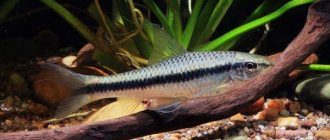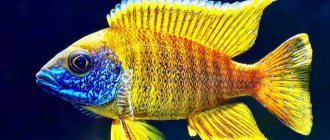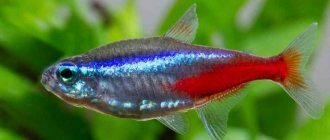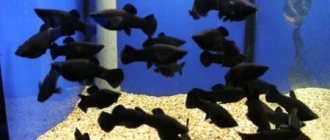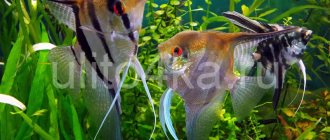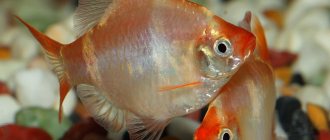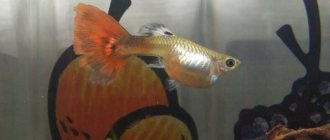A small fish with a difficult character is a labeo. Outwardly, it resembles a catfish, but has nothing in common with it. This is a representative of the carp family. Before you keep a labeo in your home aquarium, you need to study its behavioral characteristics: this fish cannot get along with all its inhabitants and requires special conditions. It is recommended that those who already have experience keeping pet fish pay attention to labeo.
Description
There are several varieties of labeo, differing in color. General characteristics: elongated dense body, slightly flattened laterally. The back line is curved, the belly line is flat. The muzzle is pointed, the mouth is located lower, its shape resembles a suction cup, framed by a pair of antennae. Due to the structure of its mouth, the labeo can scrape plaque from surfaces in the aquarium, which is why it is often called a catfish. Labeo's fins are well defined. The spinal one starts from the middle of the back with high rays, is short, ends with low rays, reminiscent of a sail. The pectoral, pelvic and anal fins are approximately the same size. The tail is a pitchfork blade, with long outer rays that evenly shorten towards the middle.
Appearance
The male's body is always slimmer and brighter, which must be taken into account when purchasing fish. The body shape is elongated, somewhat similar to a carp, but not so tall. The mouth is located at the bottom. It is a suction scraper. There are antennae on the sides of the mouth.
Bicolor
The classic bicolor labeo (also called bicolor labeo) has a black velvet body with a bright red caudal fin. This black fish with a red tail is the most common species. The pet is quite large and, with proper maintenance, grows up to 16 cm. The minimum size for a properly developing fish of this variety is 12 cm .
Green
Green labeos are smaller and do not grow more than 12 cm. The main body color is olive with a black stripe along the head. There is also a black spot near the caudal fin. All fins have a beautiful, rich red-orange color.
Albino
The albino labeo fish is artificially bred and can be of any of two types - bicolor or green. Her body is golden yellow with fairly light reddish fins.
Black Labeo
There is also a form of black labeo, in which several golden scales stand out brightly against the background of the main color on the body. For now, this species is almost impossible to find on sale.
Types of labeo
- Labeo bicolor (two-color) is the most famous representative. The textured coloring made the fish very popular. Its body is velvety black or dark gray, the fins are the same color as the body, except for the tail: it is bright red. The size of an adult fish in an aquarium is 12-15 cm, in nature they reach 20 cm;
- labeo green (Thai) - has a slightly smaller size compared to bicolor. The body color varies from greenish-gray to dark olive, the abdomen is lighter. All fins are bright red. How long do labeos live in an aquarium: up to 8 years;
- Labeo albino is a fish with a two-color color: the whole body is white-pearl, the caudal fin is red, as are the eyes. Of all the Labeos, they are the most peaceful and calm;
- Labeo black (black morulius) – has a dense, voluminous body that is completely black. The size of an adult specimen allows Morulis to be kept only in huge aquariums: the individual grows up to 60 cm in length. This is when kept in an aquarium; in nature, the black labeo grows up to 90 cm. However, the body proportions, curvature of the back and flat abdomen remain standard. There is a luxurious fin-sail on the back.
Aquarium fish labeo two-color: description
Sometimes they are called labeo bicolor. These are inhabitants of small rivers, streams and lakes in Thailand. This species appeared in Europe in 1952, and was brought to Russia in 1959. Labeo bicolor has a slender, slightly elongated body with a curved back and flattened sides. Her head is small, and her eyes are red and disproportionately large.
The mouth is surrounded by two pairs of whiskers and horny villi. It is located at the bottom and looks like a suction scraper. The fish is famous for its spectacular coloring - it seems that its body is covered with black velvet. The dorsal fin is black, high and sharp. The pectoral fins, as well as the anal and ventral fins, are well developed, but not colored - they are transparent.
The main decoration of these fish are their red tails. These fins are quite long, forked at the end, and fiery red in color. Females of two-colored labeos are much larger than males, but slightly paler in color. Under natural conditions they grow up to thirty centimeters in length, and aquarium labeos rarely exceed fifteen.
Maintenance and care
The life expectancy, health and activity of fish depend on the correct conditions of detention.
- weekly cleaning of the soil with a special siphon;
- changing water simultaneously with cleaning the soil, approximately 20% of the volume is replaced;
- brown and green algae are one of the important parts of the fish’s diet. Suitable conditions must be created for their appearance. Brown algae appear in insufficient light, so low-key lighting in an aquarium with labeo is recommended. Green algae, on the other hand, grow in bright light, so they are grown separately. For example, you can place glass or stone in a jar, fill it with water and place it on the windowsill. When the object turns green, it is placed in the labeo’s aquarium and left until completely cleaned;
- feeding once a day;
Arrangement of the aquarium
- the volume of the aquarium is calculated by the number of individuals. There should be 60-80 liters per fish. The exception is the black labeo, which requires a tank with a capacity of 600 liters or more;
- soil - any is suitable, preferably small pebbles with a fraction of 3-5 mm;
- The filter must not only clean and disinfect water efficiently, but also create a strong current. For large aquariums, a remote filtration system is recommended;
- aeration – intensive, with a separate compressor;
- lighting is moderate, there should be shaded areas where the labeo can hide;
- aquarium plants are planted in the form of dense thickets, which are perfect as shelters;
- driftwood, stones, and grottoes are used to decorate the bottom. The landscape should contain holes, caves, and depressions;
- Labeos love peat water; to do this, place a piece of peat in the filter and change it every 2-3 weeks.
Water parameters
- temperature 24-27°C;
- hardness 4-20° (for bicolor - 10°);
- acidity 6.5-7.8 pH (for bicolor not lower than 7.2).
Keeping in an aquarium
If we talk about the two-color labeo fish, its maintenance will require a spacious aquarium. The volume must be at least 200 liters. The more free space the fish has, the less aggressive it will be towards other individuals.
The requirements for keeping an aquarium are as follows:
- Be sure to cover the top with a lid or glass, since the labeo often jumps out of the water and can fall to the floor and die.
- The water in the aquarium must be fresh and clean, so you will need to install a filter and change about 1/5 of the water weekly.
- The optimal water temperature for two-color labeo is in the range from +22 to +26C.
- Water hardness is desirable with average values (5−15°), PH 6.8−7.5.
- It is advisable to organize the conditions in the aquarium in such a way that they resemble natural ones as much as possible. For this purpose, artificial caves and shelters are constructed, and driftwood is laid out.
- It is best to lay gravel or small smooth stones at the bottom of the reservoir.
- It is preferable to choose plants that take root well.
- Since the labeo's diet includes microscopic algae, the aquarium must have bright lighting to ensure their active growth.
There are a number of requirements for fish habitat
Behavior and Compatibility
This aquarium fish becomes very territorial as it ages. So much so that aquarists have compiled a description of the rules by which Labeo should be kept:
- number of individuals in the aquarium: one or more than three. A war will begin between two Labeos, and the strongest will win;
- it is not advisable to place young fish with the older generation: the young fish most likely will not cope with the struggle for territory;
- The space on the bottom must be designed so that the zones for each fish are clearly visible. Stones, driftwood, and thickets of plants can serve as partitions;
- When feeding, you should try to distribute the food over the entire bottom so as not to provoke the labeo into conflicts.
The fish are aggressive towards each other. Other inhabitants of the aquarium may be harmed if they swim too close to the Labeo's home. Therefore, those fish that rarely go to the bottom will be suitable neighbors: angelfish, barbs, tetras. The fish must be able to move quickly and not provoke conflict situations. The compatibility of Labeo with other inhabitants of the aquarium is a very fine-tuning process. Some aquarists easily manage to organize a peaceful environment in the aquarium, while others have to constantly come up with new ways to protect the fish from the attacks of the labeo.
It is noteworthy that Labeo can be trained to be handled. They willingly make contact with humans, recognize the owner, and behave actively during feeding.
Features of character and lifestyle
Photo: Two-color labeo from the Red Book
The two-color labeo is a very agile and nimble fish. Both in a natural body of water and in an aquarium, it prefers to live closer to the bottom. It can lie on the bottom and crawl along it a little. You can also sometimes observe how a labeo becomes vertical or turns over with its belly up - this does not mean that it needs help, it can swim like that.
The main time of activity occurs at dusk. In them, the two-color labeo shows especially great mobility, can swim throughout the aquarium and chase smaller fish. All Labeos are prone to this behavior to a greater or lesser extent, so you should carefully select their neighbors.
These fish are smart: if the owner is unhappy because of their aggression, they hide from him behind some bush and calm down for a while. They wait until he moves away from the aquarium and stops watching them, and only after that they get back to their business.
They are kept together with other fish, but a spacious aquarium is still required, and the labeo's neighbors should not resemble their relatives. It is best if they have a completely different color - they are much more tolerant of such fish, but all individuals with a bright tail cause them a burning hostility.
It is preferable to keep them with neighbors who can endure their attacks without much difficulty, and it is necessary to make special shelters in which to wait out the danger. Albino labeos cannot be kept with normal ones - they are more delicate and need a calm environment.
Reproduction
Labeos do not reproduce at home. To stimulate spawning, you need to carry out hormonal injections and strictly monitor water parameters. This is done by specialists from “fish farms” in Southeast Asia. Industrial catching of labeo from natural reservoirs is prohibited, so people have learned to stimulate reproduction in farm conditions.
How to determine gender. Females and males differ little in appearance; sexual differences are visible only to specialists. Weak signs of sex appear over the age of one year: males become a little more graceful, and females have a slightly lighter abdomen. Experts involved in breeding labeos notice that there are always significantly fewer males in the population and they are weaker than females.
Feeding
Labeos are not very picky about food. They happily consume live food. These are bloodworms, daphnia, and tubifex. They do not refuse plant foods and special dry food. If you want to diversify your pets' diet, scald lettuce leaves and give them small pieces, use frozen spinach, pieces of zucchini and cucumber, and oatmeal.
These fish, according to their owners, are very happy when a sheet of glass covered with algae appears in their house. They eat them with pleasure. It is recommended to feed Labeo twice a day. With good care and proper feeding, this type of fish lives up to 12 years.
Labeo diseases
Adult fish have excellent immunity, resistant to many diseases. If the causative agent of the disease enters the water in small quantities, infecting weaker neighbors, the labeo can remain healthy.
Good immunity is possible only under ideal conditions and the absence of stress. If the fish is exposed to regular temperature fluctuations, oxygen deficiency, if it does not consume brown and green algae, the immune system becomes susceptible to infections.
- dropsy: bloating, ulcers on the surface of the body, decreased appetite;
- mucous: apathy, impotence, whitish coating on the body.
In these cases, the fish should be placed in a quarantine aquarium and treated with antibacterial drugs in the dosage indicated on them.
Disease prevention includes a properly designed aquarium, clean care equipment, and disinfected decorative items.
Population and species status
Photo: Two-color labeo fish
After the discovery of bicolor labeos in the Chhaupraya River basin in the 1930s, they began to spread as aquarium fish, and in the 1950s they began to be imported to Europe. At the same time, the population in nature was sharply declining due to several factors - active fishing, pollution of rivers in the habitat, and the construction of dams.
As a result, in the 1960s, the two-colored labeo was included in the list of species extinct in nature. At the same time, a large population of them lived in aquariums around the world, and it only grew thanks to mass breeding on special farms.
A couple of decades ago, it turned out that they were too hasty in listing this species as extinct - in a remote corner of Thailand, reservoirs were discovered in which the two-colored labeo was preserved. But the population of the species is small, and therefore it is placed in the Red Book as critically endangered.
The population in the wild must be protected, because although many representatives of this species live in captivity, they cannot simply be released into the wild, and this applies not only to fish raised in an aquarium, but even to eggs or fry. It is extremely difficult to reintroduce the bicolor labeo, and so far this has not been possible.
Interesting fact: One of the most common diseases in two-color labeo is mucous skin. When it hits, you can notice a light coating on the fish, it becomes lethargic and moves jerkily, and may even begin to rub against stones. The disease is caused by poor quality water and excessive crowding. To cure, it is necessary to use special drugs - simply moving to a more favorable environment is not enough.
Similar fish
- Labeo black . It is distinguished by its absolutely black deep color and larger size. Omnivorous and gluttonous. Very often, its vital activity leads to the complete destruction of all aquarium vegetation.
- Garra rufa is a famous doctor fish from the Karpov family. It also comes from Thailand, where it is widely used in folk medicine (for example, to treat psoriasis). Very demanding of conditions in captivity.
- Schubert's Barbus . A bright and active golden-yellow fish, very easy to keep. However, it is characterized by increased aggressiveness and a short life in an aquarium.
- Labeo green. It differs from its two-color counterpart in having a less contrasting and expressive color. It is considered the most friendly and non-aggressive representative of the Labeo.
Diseases and treatments
Labeos rarely get sick. Characteristic diseases include aeromonosis (dropsy), mucous skin and stress.
The first disease can be identified by the following symptoms:
- Due to the accumulation of fluid, the fish's abdominal cavity swells, its scales protrude, and bulging eyes develop. At the first stage of the disease, bacterial damage to the intestines occurs, from which mucous discharge appears;
- the fish's appetite decreases;
- the separation of parts of the intestinal mucosa begins, which exit through the anus;
- the function of the kidneys and urinary tract is impaired. This prevents water from leaving the fish’s body, which leads to characteristic external manifestations.
The drug Oxytetracycline is used to treat dropsy. It is used in injection form or added to food. Treatment is continued for 7–14 days.
When the skin is mucous, thick gray or white mucus appears on the body of the fish. In this case, the following measures must be taken:
- The first thing you need to do is measure the pH in your aquarium. If acidity is low, it is necessary to replace ¼ of the water. If the pH values are normal, we can conclude that ectoparasites or a bacterial infection have settled on the fish’s body.
- One day after changing the water, add FMC to the aquarium. It is combined with the antibacterial agent Furazolidone. Grind the tablets, dilute the resulting powder in warm water, and then pour this solution into the aquarium. Treatment should be continued for 3–4 days.
- If after this time the condition of the fish does not improve, proceed to the use of Azipirin. Sick fish are placed in such a bath for 3 hours. In most cases, one treatment is sufficient. But if necessary, the drug is reused.
If the color of the labeo becomes pale, this often indicates emotional or physical discomfort. To relieve your fish of stress, you first need to find out its cause. This may be a lack of shelter, a violation of the temperature or acidity level, aggression from another individual, an inappropriate aquarium size, or poor quality food. After these factors are eliminated, the fish’s condition returns to normal.
To keep a labeo you will need: a spacious aquarium, certain water parameters and high-quality nutrition consisting of live and plant food. Breeding these fish requires special skills, so labeos are more suitable for experienced aquarists.
- Author: Yana Dmitrova
Hello! Let's get acquainted, my name is Dmitrieva Yana, a manager of foreign economic activity by education. Rate this article:
- 5
- 4
- 3
- 2
- 1
(0 votes, average: 0 out of 5)
Share with your friends!
